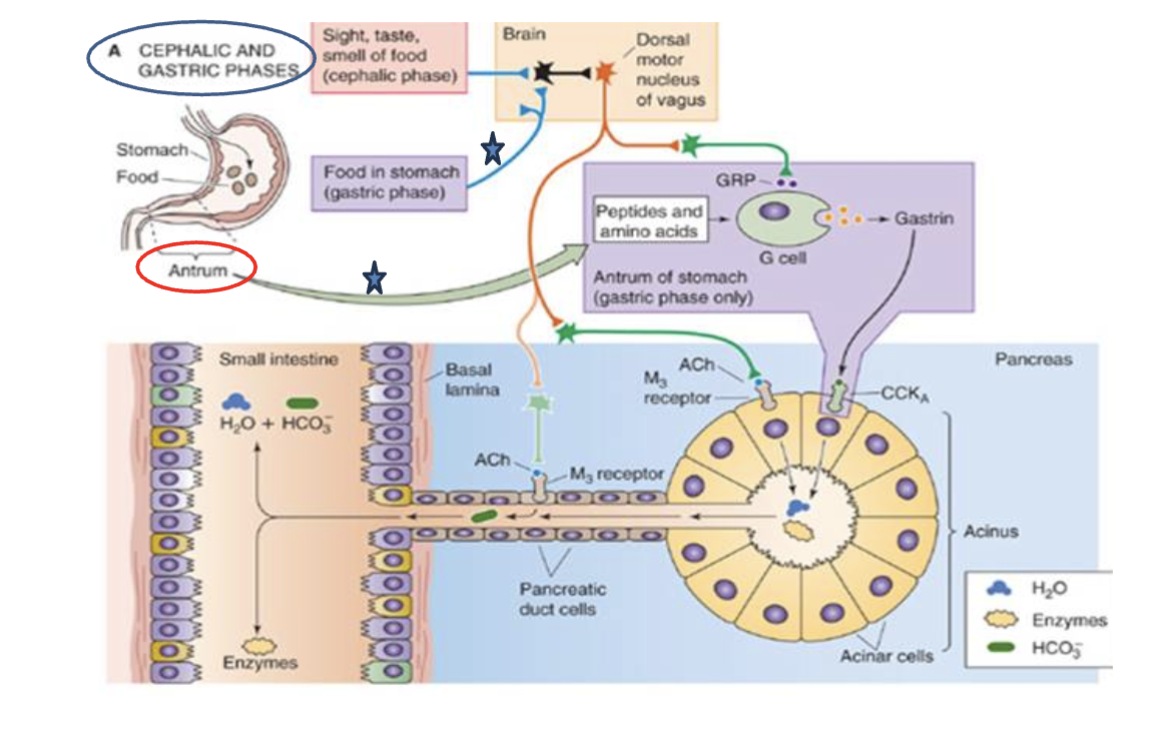Life Maintenance cram
1/4
There's no tags or description
Looks like no tags are added yet.
Name | Mastery | Learn | Test | Matching | Spaced |
|---|
No study sessions yet.
5 Terms
Anions in pancreatic juice:
HCO3-
Cl-
SO42-
HPO42-
Cations in pancreatic juice:
Na+
K+
Ca2+
Mg2+
Secretin … the volume of pancreatic juice produced by the pancreas.
HCO3- … under it, which makes sense cos secretin promotes it and this makes the juice for alkaline.
Cl- … because they are exchanged for biocarb ions.
Amylase … because there is a dilution effect as the volume of pancreatic juice increases.
inc
inc
dec
dec
In the cephalic and ductile phases, explain what happens in the stimulation of acinar and duct cells

🧠 1. Cephalic and Gastric Phases (Top Left)
Cephalic phase: Triggered by sight, smell, taste, or thought of food.
Sensory input → brain → Dorsal motor nucleus of the vagus.
Vagal stimulation (orange line) leads to parasympathetic outflow to the stomach and pancreas.
Gastric phase: Triggered by presence of food in the stomach.
Particularly important in the antrum, which senses peptides and amino acids.
Stimulates G cells (see below).
🧬 2. Stimulation of G Cells in the Antrum (Purple Box)
Peptides and amino acids from digested proteins stimulate G cells.
G cells release gastrin, which:
Enhances acid secretion.
Indirectly promotes pancreatic enzyme secretion.
The vagus nerve also stimulates G cells via Gastrin-Releasing Peptide (GRP).
💧 3. Acinar Cells (Bottom Right – Yellow Cells in “Acinus”)
These cells secrete digestive enzymes (yellow blobs in the duct).
Stimulated by:
ACh (vagus nerve) → binds to M₃ receptors.
CCK from I cells (not shown here, but released in the small intestine in response to fats and proteins) → binds to CCK_A receptors.
Together, ACh and CCK boost enzyme secretion to digest proteins, fats, and carbs.
💨 4. Pancreatic Duct Cells (Bottom Left – lining the duct)
These cells secrete:
Bicarbonate (HCO₃⁻) and water into the ducts.
This neutralizes acidic chyme coming from the stomach.
Stimulated by:
ACh (via M₃ receptors).
Secretin (not shown in this diagram, but secreted by S cells in the duodenum when pH drops).
📉 Reciprocal Changes (from your earlier question):
As bicarbonate secretion increases, chloride (Cl⁻) is reabsorbed (Cl⁻/HCO₃⁻ exchanger).
So, high secretin → high HCO₃⁻, low Cl⁻ in the pancreatic juice.
Boundaries of the epiploic foramen
Ant, post, dup, inf
Ant: hepatoduodenal ligament (inc portal triad)
Post: IVC and right crus of diaphragm (parietal peritoneum)
Sup: Liver
Inf: Superior duodenum